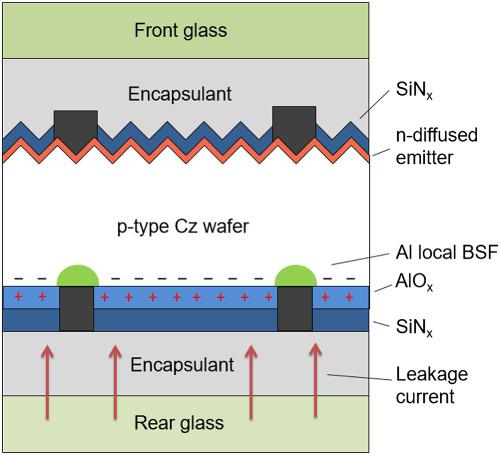当前位置:
X-MOL 学术
›
Prog. Photovoltaics
›
论文详情
Our official English website, www.x-mol.net, welcomes your feedback! (Note: you will need to create a separate account there.)
Elucidating potential‐induced degradation in bifacial PERC silicon photovoltaic modules
Progress in Photovoltaics ( IF 6.7 ) Pub Date : 2018-06-05 , DOI: 10.1002/pip.3028 Wei Luo 1, 2 , Peter Hacke 3 , Kent Terwilliger 3 , Tian Shen Liang 1, 4 , Yan Wang 1 , Seeram Ramakrishna 1, 2 , Armin G. Aberle 1, 4 , Yong Sheng Khoo 1
Progress in Photovoltaics ( IF 6.7 ) Pub Date : 2018-06-05 , DOI: 10.1002/pip.3028 Wei Luo 1, 2 , Peter Hacke 3 , Kent Terwilliger 3 , Tian Shen Liang 1, 4 , Yan Wang 1 , Seeram Ramakrishna 1, 2 , Armin G. Aberle 1, 4 , Yong Sheng Khoo 1
Affiliation

|
This paper elucidates the behavior and underlying mechanism of potential‐induced degradation (PID) on the rear side of p‐type monocrystalline silicon bifacial passivated emitter and rear cell (PERC) photovoltaic modules. At 50°C, 30% relative humidity, and −1000 V bias to the solar cells with aluminium foil on the rear glass surface, the rear‐side performance of bifacial PERC modules at standard testing conditions degraded dramatically after 40 hours with a 40.4%, 36.2%, and 7.2% loss in maximum power (Pmpp), short‐circuit current (Isc), and open‐circuit voltage (Voc), respectively. The front‐side standard testing condition performance, on the other hand, showed less degradation; Pmpp, Isc, and Voc dropped by 12.0%, 5.2%, and 5.3%, respectively. However, negligible degradation was observed when the solar cells were positively biased. Based on I‐V characteristics, electroluminescence, external quantum efficiency measurements, and the effective minority‐carrier lifetime simulation, the efficiency loss is shown to be caused by the surface polarization effect; positive charges are attracted to the passivation/antireflection stack on the rear surface and reduce its field effect passivation performance. Extended PID testing to 100 hours showed an increase in device performances (relative to 40 hours) due to the formation of an inversion layer along the rear surface. In addition, replacing ethylene‐vinyl acetate copolymer with polyolefin elastomer films significantly slows down the progression of PID, whereas a glass/transparent backsheet design effectively protects the rear side of bifacial PERC modules from PID. Furthermore, PID on the rear side of bifacial PERC modules is fully recoverable, and light greatly promotes recovery of the observed PID.
中文翻译:

阐明双面PERC硅光伏模块中的电势退化
本文阐明了p型单晶硅双面钝化发射极和后电池(PERC)光伏模块背面的电势退化(PID)的行为和潜在机理。在50°C,30%相对湿度和-1000 V偏压的太阳能电池上,铝箔在后玻璃表面上,双面PERC模块在标准测试条件下的背面性能在40小时后以40.4%的速度急剧下降。最大功率(P mpp),短路电流(I sc)和开路电压(V oc)分别降低了36.2%和7.2%。另一方面,前端标准测试条件性能显示出较少的退化;P MPP,I sc和V oc分别下降了12.0%,5.2%和5.3%。但是,当太阳能电池正偏时,观察到的降解可忽略不计。基于IV特性,电致发光,外部量子效率测量以及有效的少数载流子寿命模拟表明,效率损失是由表面极化效应引起的;正电荷被吸引到背面的钝化/减反射叠层并降低其场效应钝化性能。PID测试延长至100小时后,由于沿后表面形成了反型层,因此设备性能有所提高(相对于40小时)。此外,用聚烯烃弹性体薄膜代替乙烯-乙酸乙烯酯共聚物会显着减慢PID的进程,而玻璃/透明背板设计可有效保护双面PERC模块的背面免受PID的影响。此外,双面PERC模块背面的PID是完全可恢复的,
更新日期:2018-06-05
中文翻译:

阐明双面PERC硅光伏模块中的电势退化
本文阐明了p型单晶硅双面钝化发射极和后电池(PERC)光伏模块背面的电势退化(PID)的行为和潜在机理。在50°C,30%相对湿度和-1000 V偏压的太阳能电池上,铝箔在后玻璃表面上,双面PERC模块在标准测试条件下的背面性能在40小时后以40.4%的速度急剧下降。最大功率(P mpp),短路电流(I sc)和开路电压(V oc)分别降低了36.2%和7.2%。另一方面,前端标准测试条件性能显示出较少的退化;P MPP,I sc和V oc分别下降了12.0%,5.2%和5.3%。但是,当太阳能电池正偏时,观察到的降解可忽略不计。基于IV特性,电致发光,外部量子效率测量以及有效的少数载流子寿命模拟表明,效率损失是由表面极化效应引起的;正电荷被吸引到背面的钝化/减反射叠层并降低其场效应钝化性能。PID测试延长至100小时后,由于沿后表面形成了反型层,因此设备性能有所提高(相对于40小时)。此外,用聚烯烃弹性体薄膜代替乙烯-乙酸乙烯酯共聚物会显着减慢PID的进程,而玻璃/透明背板设计可有效保护双面PERC模块的背面免受PID的影响。此外,双面PERC模块背面的PID是完全可恢复的,


























 京公网安备 11010802027423号
京公网安备 11010802027423号